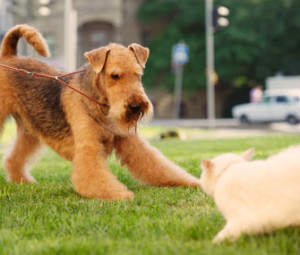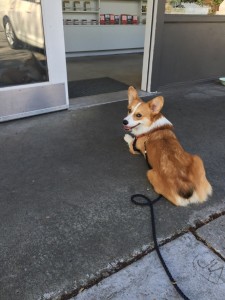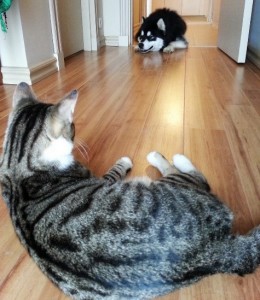 Having grown up in a home where we had three cats living very happily with a dog I never really put much thought into households where the union was not as harmonious. However my time at Dogs Trust showed me clearly that some dogs and cats simply do not get along and others, with a tonne of hard work and patience from their family, can beat the odds and end up best of friends.
Having grown up in a home where we had three cats living very happily with a dog I never really put much thought into households where the union was not as harmonious. However my time at Dogs Trust showed me clearly that some dogs and cats simply do not get along and others, with a tonne of hard work and patience from their family, can beat the odds and end up best of friends.
Ok so you have decided to bring a new addition into your home – be it a new cat or a new dog – you need to set up the environment so you are keeping both animals safe and as stress free as possible.
Try to create “safe zones” for each animal so they are not able to come into contact with one another outside of the training sessions. The reason we do this is we want to ensure not only is everyone kept safe but also that they are not getting to practice any undesirable behaviours, after all practice makes perfect with all behaviour, good or bad.
Baby gates are a fantastic invention when you are introducing a new dog or cat to your home as it allows your cat an escape route (unless your dog is very agile) and also gives you peace of mind in a multi-person household that if someone leaves a door open the dog and cat will not come into contact with one another.
Remember bringing a new pet into your home can be difficult for everyone so it is important to recognise that your cat and dog will need some nice one to one time with the family. We also want to help them practice as much relaxed, natural behaviour as possible.
Introducing your cat and dog harmoniously;
 Set your cat up in a nice quiet area of the house where they can relax – if possible give them a space where they can be up off the floor, such as an armchair or bed etc.
Set your cat up in a nice quiet area of the house where they can relax – if possible give them a space where they can be up off the floor, such as an armchair or bed etc.
Pop a harness and light lead on your dog in the house and set yourself up with some nice tasty, high value treats you know your dog will enjoy e.g. chicken, ham, sausage, hotdog, cheese etc. The pieces of food need to be small enough that your dog is not going to get full quickly. A good guide is the size of your baby finger nail for a little dog up to the size of your thumb for a giant breed.
Note: If your dog gets super excited when their lead appears as they are anticipating a nice walk, take them out for a short jaunt around the block to help them burn off some steam and be nice and relaxed for the beginning of the training.

If the dog knows any cues (sit, down, paw etc) practice these in a separate room to encourage calm focus on you, the handler. Once the dog is able to focus on you consistently, start to decrease the distance between you and the cat. Depending on the severity of the issue between the dog and cat you may need to start this training at the furthest point in the house from one another.
If your dog is not focusing on you, this is not down to them being “bold” or “disobedient” it is simply because they can’t.
If this happens you need to assess the situation – is the dog too close to the room the cat is in? Is there too much going on in the house i.e. they are distracted? Are they hungry or full – to get the best focus on you during training we want them to have an appetite but not be completely ravenous. Also is the food the right value – too high value can be very exciting and then all the dog can think about or too low value and therefore not really worth working for.
It is also important to remember don’t be tempted to rush the sessions as you want to ensure the dog is calm and relaxed at all times. If you leap forward several steps you will likely have to go right back to the beginning. All training is time consuming and each dog learns at a different rate so take your time, celebrate the triumphs and be confident that with some patience and hard work you will get there. Once your dog is working well for you and giving good focus while practicing their cues you can start to gradually reduce the distance from the area the cat is in.
Ultimately you want to get to a point where the dog is able to be right up next to the closed door, where they will certainly be able to smell the cat, and still able to offer a nice behaviour such as sit on cue.
At this point you have two options and this will be dependent on the specific relationship you are working on i.e. if the dog is very highly aroused and showing aggressive behaviour towards the cat or just looking to chase or bother them.
If your dog is highly reactive;
We need to up their skill set before exposing them to seeing the cat. There are five really nice cues that are helpful when working with a dog that is showing aggressive behaviour to another animal.
- This Way or Lets Go cue
- Look at That or LAT cue
- Watch Me or Look cue
- Touch cue
- Come cue
You can absolutely work on teaching these behaviours yourself. However, I would advise speaking with a force free trainer if you feel that your dog is not simply excited by the presence of the cat and there is any risk of injury to either animal.
If your dog is simply excited by the presents of another animal;
 If your dog is simply excited by the cat and looking to play you can focus instead on teaching incompatible behaviours and capturing calm settled behaviour when they are around one another. Once you have gotten your dog to a point where your dog is calm and relaxed, offering practiced cues all the way up to the door of the room the cat is inside, gradually open the door to allow the dog to see inside – relaxed body language, air sniffing and easily distracted back to the handler – lots of fuss and reward. If the dog begins to strain on the lead or bark, immediately (calmly) use your voice to call them away & create more distance. If necessary close the door and reset them giving them a couple of seconds and then ask for an easy cue. If they don’t respond, move away from the door and calmly ask again. Remember it is ultimately up to us as the handler to ensure we are enabling them to be successful and not their fault if they are making mistakes. Break down the steps even further if necessary and perhaps recruit an assistant to open the door for you while you stand a few feet back with your dog.
If your dog is simply excited by the cat and looking to play you can focus instead on teaching incompatible behaviours and capturing calm settled behaviour when they are around one another. Once you have gotten your dog to a point where your dog is calm and relaxed, offering practiced cues all the way up to the door of the room the cat is inside, gradually open the door to allow the dog to see inside – relaxed body language, air sniffing and easily distracted back to the handler – lots of fuss and reward. If the dog begins to strain on the lead or bark, immediately (calmly) use your voice to call them away & create more distance. If necessary close the door and reset them giving them a couple of seconds and then ask for an easy cue. If they don’t respond, move away from the door and calmly ask again. Remember it is ultimately up to us as the handler to ensure we are enabling them to be successful and not their fault if they are making mistakes. Break down the steps even further if necessary and perhaps recruit an assistant to open the door for you while you stand a few feet back with your dog.
 Once the dog is able to offer calm relaxed focus in the doorway and the cat does not appear distressed you can allow the dog to move closer. Try to tune into the body language of your dog so you can pre-empt them becoming aroused and if necessary create more distance. It is equally important to also be as relaxed as you possibly can when doing this training as any tension you are feeling travels like a lightening bolt straight down the lead into your dog – I appreciate that this is a tall order trying to balance the two but you should have done enough preparation at this point that your dog is calm and relaxed, so you just need to trust yourself that you are managing the situation and keeping everyone safe.
Once the dog is able to offer calm relaxed focus in the doorway and the cat does not appear distressed you can allow the dog to move closer. Try to tune into the body language of your dog so you can pre-empt them becoming aroused and if necessary create more distance. It is equally important to also be as relaxed as you possibly can when doing this training as any tension you are feeling travels like a lightening bolt straight down the lead into your dog – I appreciate that this is a tall order trying to balance the two but you should have done enough preparation at this point that your dog is calm and relaxed, so you just need to trust yourself that you are managing the situation and keeping everyone safe.
Once the dog is able to be in the same room near the cat with everyone being nice and relaxed and calm you are ready to start generalising this to other areas of the house. Again the dog will need to be kept on lead wearing a harness and if possible the cat on a raised area so they have a safe zone. You will also need to start the process again at a distance gradually getting closer as this will ensure the dog stays under their arousal threshold.
 Ideally you want to get to a point where the dog is so focused on you that the cat being there is secondary. In time as the cat becomes more relaxed in the presence of the dog they should be more inclined to move about the room.
Ideally you want to get to a point where the dog is so focused on you that the cat being there is secondary. In time as the cat becomes more relaxed in the presence of the dog they should be more inclined to move about the room.
You may need to up the value of the food you are using at this point and really work your dog with a high rate of reinforcement (i.e. lots of treats in quick succession for desired behaviours) as movement, particularly for dogs who like to chase things is much more stimulating then a stationary cat.

However lots of dogs and cats can learn to harmoniously cohabit so it is always worth while exploring this under the guidance of a professional trainer.
Any questions feel free to pop them in the comments section below.
Happy training everyone… 

